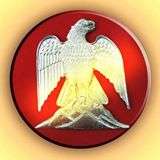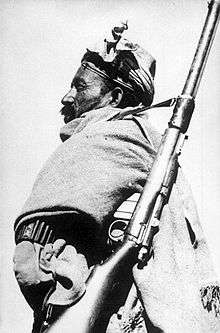Frontier Corps
| Frontier Corps | |
|---|---|
 | |
| Active | 1878–present |
| Country |
|
| Allegiance |
|
| Branch | Paramilitary forces of Pakistan |
| Type | Paramilitary |
| Role | Law enforcement/Border patrol |
| Size | ≈80,000 |
| Part of |
Ministry of Interior (MoI) Ministry of Defence (MoD) |
| Garrison/HQ |
Peshawar, Khyber-Pakhtunkhwa Quetta, Baluchistan |
| Website | http://www.frontiercorps.gov.pk/ (Khyber Pakhtunkhwa) http://www.fcbalochistan.gov.pk (Balochistan) |
| Commanders | |
| Inspector General, Peshawar | Major-General Tayyab Azam |
| Inspector General, Quetta | Major-General Sher Afgun |
The Frontier Corps (Urdu: سرحد واہنی) (reporting name: FC), is an umbrella term for the two provincial auxiliary forces part of the paramilitary forces of Pakistan along the western provinces of Balochistan and Khyber Pakhtunkhwa and are the direct counterparts to the Rangers of the eastern provinces (Sindh and Punjab). The Frontier Corps comprises two separate organizations: FC NWFP stationed in Khyber Pakhtunkhwa province (formerly known as the North-West Frontier Province), and includes the Federally Administered Tribal Areas, and FC Balochistan stationed in Balochistan province. Each subdivision is headed by a seconded inspector general, who is a Pakistan Army officer of at least major-general rank, although the force itself is under the jurisdiction of the Interior Ministry.[1]
With a total manpower of approximately 80,000,[2] the task of the Frontier Corps is to help local law enforcement in the maintenance of law and order, and to carry out border patrol and anti-smuggling operations.[3]
History

The Frontier Corps was created in 1907 by Lord Curzon, the viceroy of British India, in order to organize seven militia and scout units in the tribal areas along the border with Afghanistan: the Khyber Rifles, the Zhob Militia, the Kurram Militia, the Tochi Scouts, the Chagai Militia, the South Waziristan Scouts and the Chitral Scouts.[1]
The Frontier Corps was led by an "inspecting officer" who was a British officer of the rank of lieutenant colonel. In 1943 the inspecting officer was upgraded to an inspector general (an officer with the rank of brigadier), and the corps was expanded with new units (the Second Mahsud Scouts were raised in 1944 and the Pishin Scouts in 1946).[1]
After independence in 1947, Pakistan expanded the corps further by creating a number of new units, including the Thal Scouts, the Northern Scouts, the Bajaur Scouts, the Karakoram Scouts, the Kalat Scouts, the Dir Scouts and the Kohistan Scouts. British officers continued to serve in the Frontier Corps up to the early 1950s. The corps was split into two major subdivisions with FC Balochistan incorporating the Zhob Militia, the Sibi Scouts, the Kalat Scouts, the Makran Militia, the Kharan Rifles, the Pishin Scouts, the Chaghai Militia and the First Mahsud Scouts.[1] In 1975, three of the units (the Gilgit Scouts, the Karakoram Scouts and the Northern Scouts) were merged to form a new paramilitary force called the Northern Light Infantry, which is now a full infantry regiment of the Pakistan Army.[4]
In the mid-1970s, the Pakistani government used FC Balochistan to counter the terrorists in Balochistan and the force is unpopular among some of the local population who associate them with human rights violations and heavy- handed operations. To improve the corps image, it has been involved in construction of schools and hospitals, although as of late 2004, corps installations in the province were routinely attacked by terrorists.[1]
In the late 1990s, the Frontier Corps played an important role in eliminating opium poppy cultivation from Dir District in Khyber Pakhtunkhwa.[1]
In 2007, after the collapse of truce agreements between the Pakistani government and local militants, the Frontier Corps, teamed with regular Pakistani military units, conducted incursions into tribal areas controlled by the militants. The effort produced a series of bloody and clumsy confrontations.[5] On August 30, about 250 Pakistani troops, mostly from the Frontier Corps, surrendered to militants without a fight. In early November, most were released in exchange for 25 militants held by the Pakistan Army.[5]
There is a widespread consensus among United States government military and intelligence experts that the Frontier Corps are the best potential military units against the Islamist militants because its troops are locally recruited, know local languages and understand local cultures. The United States provided more than US$7 billion in military aid to Pakistan from 2002 to 2007, most of which was used to equip the Frontier Corps because it is in the frontline of the fight against the Islamist insurgents. From late 2007, the Pakistani government intended to expand the corps to 100,000 and use it more in fighting Islamist militants, particularly Al-Qaeda, after extensive consultations with the U.S. government and an agreement to start a multi-year effort to bolster it including the establishment of a counterinsurgency training centre.[5] The new US Obama policy for Pakistan is seen as a clear victory for the Pakistan Army lobby in the US. The $1.5billion a year aid recently announced with no strings attached will go a long way in seeing that the Frontier Corps stay at the height of their professional abilities due to new equipment and training.
The Corps has also fired occasionally on the U.S.-assisted Afghan Army."[6]
Role
- Perform Border Security duties.
- Assist Army/FCNA in the defense of the Country as and when required.
- Protect important Communication Centers and Routes.
- Undertake Counter Militancy/Criminal/Terrorism Operations on orders.
- Assist Law Enforcement Agencies in maintenance of Law and Order.
- Safeguard important sites and assets
During times of difficulties, the government occasionally gives the FC the power to arrest and detain suspects such as in late 2012[7] and early 2013 when the Prime Minister of Pakistan granted the FC policing powers.[8] These temporary powers can also be extended on the orders or consent of the provincial government or federal government or both.[9]
Organization

The senior command posts of the Frontier Corps are filled by officers seconded from the Pakistan Army for two to three years.[1]
The Scouts Training Academy, Mirali in North Waziristan is the primary training institution.
The Frontier Corps in Khyber Pakhtunkhwa is headquartered in Bala Hisar Fort in Peshawar.
The Frontier Corps in Balochistan is headquartered in Quetta and is led by Major General Sher Afgan. FC Balochistan has a manpower of more than 50,000 troops. The School of Frontier Corps and Training Centre Loralai is the primary training institution, whereas Battle School Belali is for advanced courses.[1]
The corps is divided into thirty local units—fourteen in the North-West Frontier Province and sixteen in Balochistan-and are as follows (with founding date):
- Khyber Pakhtunkhwa
- Chitral Scouts (1903)
- Khyber Rifles (1878)
- Kurram Militia (1892)
- South Waziristan Scouts (1900)
- Tochi Scouts (1894)
- Mahsud Scouts (1944)
- Mohmand Rifles
- Shawal Rifles
- Swat Scouts
- Orakzai Scouts
- Khattak Scouts
- Dir Scouts (1970)
- Bajur Scouts (1961)
- Thal Scouts (1948)
- Frontier Corps Balochistan
- Zhob Militia (1883)
- Noshki Militia (1896)
- Sibi Scouts (1971)
- Mekran Scouts(1974)
- Taftan Rifles (1977)
- Chaman Scouts (1946)
- Dalbandin Rifles (2007–08)
- Maiwind Rifles (1974)
- Ghazaband Scouts (1977)
- Bambore Rifles (1977)
- Loralai Scouts (1977)
- Qilla Abdullah Scouts (2005)
- Awaran Militia (2007)
- Panjgur Rifles (2005)
- Sui Rifles (2011)
Other units also located in Balochistan:
- School of FC and Training Centre, Loralai (FCTC)
- IAC SQN
- Frontier Corps Battle School.
- SOW (Special Operation Wing - Janinda).
Personnel
The rank and file are recruited locally, receiving tough and rigorous training but they are seldom promoted to command positions.
Equipment
The equipment of the Frontier Corps includes G3 rifles, AK-47s, RPG 7, light machine guns, handguns, short range artillery and mortars as well as aviation support and APCs and tanks.
Inspectors general
Khyber Pakhtunkhwa

After independence in 1947, the Inspectors-General of FC NWFP were:
- Brig Ahmad Jan, MBE (1950–51)
- Brig K A Rahim Khan (1951–53)
- Brig Bakhtiar Rana, MC (1953–55)

- Brig Sadiq Ullah Khan, M.C (1955–58)
- Brig Rakhman Gul, SQA, S, K, MC (1958–63)

- Brig Sadiq Ullah Khan, MC (1963–64)
- Brig Bahadur Sher, MC (1964–66)

- Brig Mahboob Khan, TQA (1966–69)
- Brig Mahmud Jan, SQA (1969–71)
- Maj-Gen Shireen Dil Khan Niazi (1971–72)
- Brig Iftikhar e Bashir (1972)
- Maj-Gen Naseerullah Babar, SJ & Bar (1972–74)
- Maj-Gen Ghulam Rabbani Khan, SBt (1974–78)

- Maj-Gen Agha Zulfiqar Ali Khan (1978–81)
- Maj-Gen Mian Muhammad Afzal (1982–84)

- Maj-Gen Arif Bangash, SBt (1984–86)

- Maj-Gen Mohammad Shafiq, SBt (1986–88)

- Maj-Gen Ghazi ud Din Rana, SBt (1988–90)
- Maj-Gen Humayun Khan Bangash, TBt (1990–91)

- Maj-Gen Muhammad Naeem Akbar Khan (1991–92)

- Maj-Gen Mumtaz Gul, TBt (1992–94)

- Maj-Gen Fazal Ghafoor, SBt (1994–97)
- Maj-Gen Sultan Habib (1997–2000)
- Maj-Gen Tajul Haq (2000–03)
- Maj-Gen Hamid Khan (2003–04)

- Maj-Gen Tariq Masood (2004–06)
- Maj-Gen Alam Khattak (2006–08)

- Maj-Gen Tariq Khan (2008–10)

- Maj-Gen Nadir Zeb (2010–2012)
- Maj-Gen Ghayur Mehmood, TBt (2012–2014)
 [10]
[10] - Maj-Gen Tayyab Azam (2014 to date)
- Maj-Gen Shaheen Mazhar (2016 to date)
Balochistan
- Maj.Gen. Syed Sadaqat Ali Shah (2001–2005)
- Maj.Gen. Shujaat Zamir Dar (2005–2007)

- Maj.Gen. Salim Nawaz (2007–2010)

- Maj.Gen. Ubaid Ullah Khan Khattak (2010–2013)

- Maj.Gen. Ejaz Shahid (2013–)
- Maj.Gen. Sher Afghan (2014-till)
Notable Deputy Inspector generals
Khyber Pakhtunkhwa
1. Brigadier Tila Mohammad (2007 to 2008)
2. Brigadier Nadir Zeb (2008 to 2010)
Balochistan
1. Brigadier Furqan (2006 to 2008)
2. Brigadier Sikandar Khan (2008 to 2009)
3. Brigadier Khalid Saleem (2013-2014)
4. Brigadier Tahir Mehmood (2014-2015)
Notable operations, incidents and controversies
- Human rights violations in Balochistan which involve the FCs use of unconstitutional force on anti-state elements in the Pakistani province of Balochistan including abductions,[11] assassinations, unlawful imprisonments/false arrest (FC do not have the same legal privileges as the police except when temporarily sanctioned by the state) and torture.
- Afghanistan–Pakistan skirmishes in which the FC was involved in beating back invading Afghan forces across the Durand Line alongside the Pakistani military.
- Kharotabad Incident occurred in 2011 in which FC personnel killed five foreigners which were possibly mistaken for militants.
- 2009 Islamabad Frontier Corps post attack which allegedly involved a suicide bomber who attacked an FC post in Islamabad.
Gallery
-
%2C_works_in_conjunction_with_a_Pakistani_service_member.jpg)
U.S. Navy Equipment Operator Constructionman working Frontier Corpsman.
-

Chitral scoutband
-

Frontier Corps Balochistan soldier (left) and the Afghan Border Police soldier (right) guards at the Durand Line's Friendship Gate, seven km southeast of Spin Boldak, Afghanistan.
-

Frontier-corps2
See also
- Naseerullah Babar
- War in Waziristan
- Military history of the North-West Frontier
- Law enforcement in Pakistan
References
- 1 2 3 4 5 6 7 8 Hassan Abbas (2007-03-30). "Transforming Pakistan's Frontier Corps". Terrorism Monitor. Washington: Jamestown Foundation. 5 (6). Archived from the original on 2008-08-04. Retrieved 2010-09-09.
- ↑ "Journey from Scratch to Nuclear Power". Pakistan Army. Retrieved 2010-09-09.
- ↑ "Miller, Greg, "U.S. military aid to Pakistan misses its Al Qaeda target"". Los Angeles Times.
- ↑ "Northern Light Infantry Regiment". Pakistan Army. Retrieved 2010-09-09.
- 1 2 3 Miller, Greg, "U.S. military aid to Pakistan misses its Al Qaeda target", Los Angeles Times, November 5, 2007, accessed November 7, 2007
- ↑ Stockman, Farah, "Pakistan aid plan facing resistance / $300m requested for paramilitaries", Boston Globe, July 22, 2007, accessed November 7, 2007
- ↑ "Balochistan unrest: FC police powers mandate gets one-month extension". The Express Tribune. 3 November 2012.
- ↑ "No Governor rule, army control: PM gives FC police powers in Quetta". The Express Tribune. 12 January 2013.
- ↑ The Newspaper's Staff Correspondent. "Police powers for FC extended".
- ↑ "Major reshuffle in the army". The News.
- ↑ "UNPO: Balochistan: Frontier Corps Burned Civilian Homes and Abducted Youth".